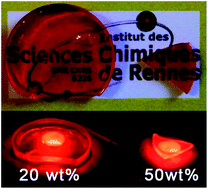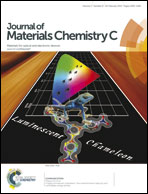Deep red luminescent hybrid copolymer materials with high transition metal cluster content†
Abstract
The hybrid strategy is a powerful approach to design functional materials by combining inorganic dyes with an organic matrix. However, introducing high contents of inorganic species within the hybrid material is a real challenge that requires a perfect balance between the interactions of both components to avoid mainly phase segregation problems. Based on our demonstration on an anionic molybdenum cluster, we present a general method to introduce high contents of such class of nanometre sized inorganic molecular deep red dyes in a polymer matrix. Our strategy exploits the physical interactions between the organic and inorganic parts of the hybrid material and allows a high cluster rate to be introduced (up to 50 wt%) in the polymer matrix. The resulting hybrids are remarkably stable even after several months of ageing. Moreover, the Mo clusters maintain their intrinsic deep red luminescence properties while the polymer organic matrix fully maintains its processability, thanks to the di-anionic character of the Mo6 clusters. Such materials show promising prospects in applications needing deep red emitters.


 Please wait while we load your content...
Please wait while we load your content...